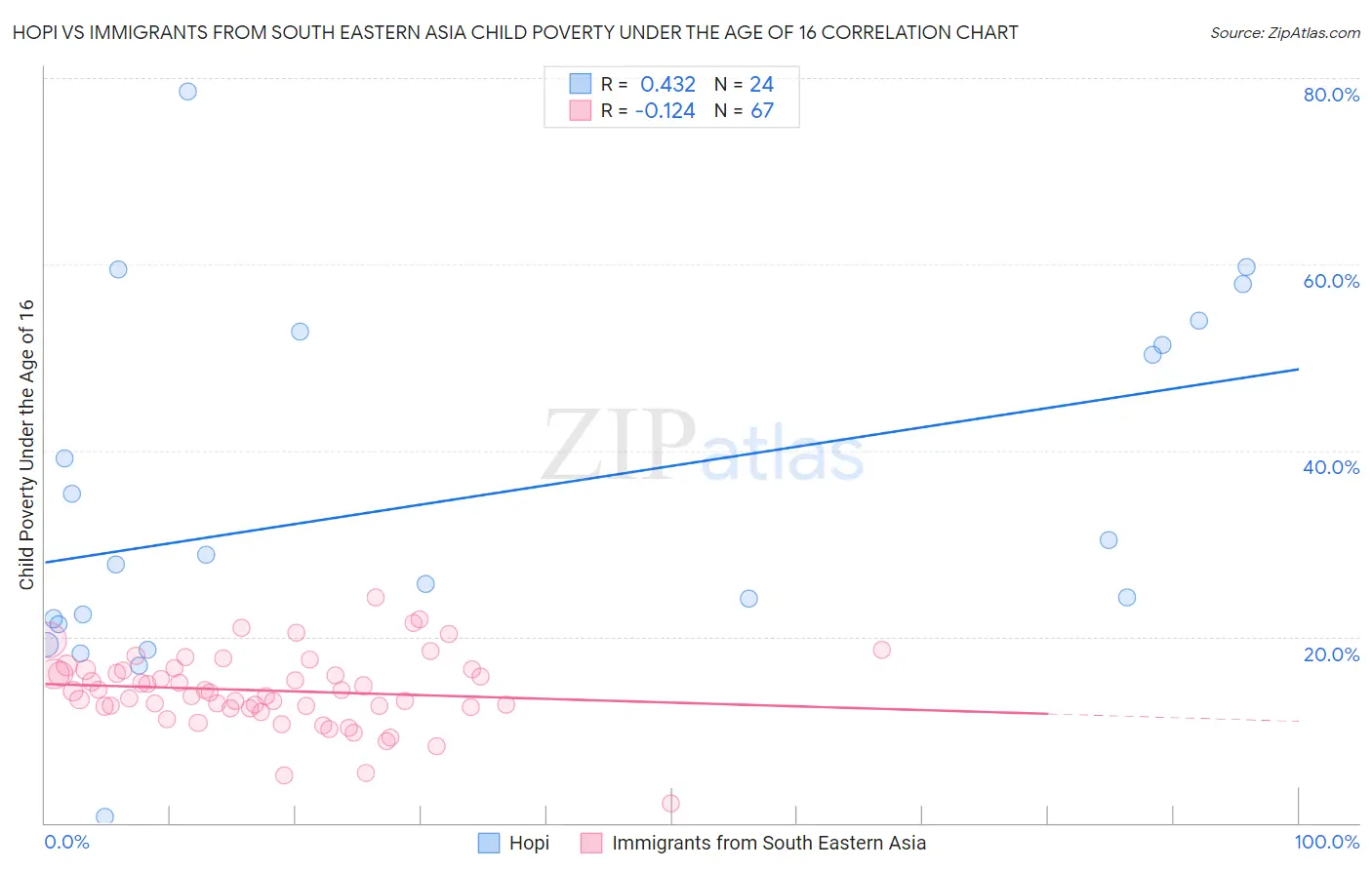Hopi vs Immigrants from South Eastern Asia Child Poverty Under the Age of 16
COMPARE
Hopi
Immigrants from South Eastern Asia
Child Poverty Under the Age of 16
Child Poverty Under the Age of 16 Comparison
Hopi
Immigrants from South Eastern Asia
27.1%
CHILD POVERTY UNDER THE AGE OF 16
0.0/ 100
METRIC RATING
340th/ 347
METRIC RANK
15.2%
CHILD POVERTY UNDER THE AGE OF 16
89.0/ 100
METRIC RATING
133rd/ 347
METRIC RANK
Hopi vs Immigrants from South Eastern Asia Child Poverty Under the Age of 16 Correlation Chart
The statistical analysis conducted on geographies consisting of 74,667,106 people shows a moderate positive correlation between the proportion of Hopi and poverty level among children under the age of 16 in the United States with a correlation coefficient (R) of 0.432 and weighted average of 27.1%. Similarly, the statistical analysis conducted on geographies consisting of 505,405,353 people shows a poor negative correlation between the proportion of Immigrants from South Eastern Asia and poverty level among children under the age of 16 in the United States with a correlation coefficient (R) of -0.124 and weighted average of 15.2%, a difference of 78.5%.

Child Poverty Under the Age of 16 Correlation Summary
| Measurement | Hopi | Immigrants from South Eastern Asia |
| Minimum | 0.70% | 2.1% |
| Maximum | 78.6% | 24.2% |
| Range | 77.9% | 22.1% |
| Mean | 34.9% | 14.2% |
| Median | 28.3% | 14.1% |
| Interquartile 25% (IQ1) | 21.6% | 12.4% |
| Interquartile 75% (IQ3) | 52.0% | 16.5% |
| Interquartile Range (IQR) | 30.4% | 4.1% |
| Standard Deviation (Sample) | 18.7% | 4.0% |
| Standard Deviation (Population) | 18.4% | 3.9% |
Similar Demographics by Child Poverty Under the Age of 16
Demographics Similar to Hopi by Child Poverty Under the Age of 16
In terms of child poverty under the age of 16, the demographic groups most similar to Hopi are Crow (26.0%, a difference of 4.4%), Yuman (28.9%, a difference of 6.8%), Cheyenne (25.4%, a difference of 6.8%), Pima (29.0%, a difference of 7.1%), and Immigrants from Yemen (29.1%, a difference of 7.3%).
| Demographics | Rating | Rank | Child Poverty Under the Age of 16 |
| Immigrants | Dominican Republic | 0.0 /100 | #333 | Tragic 24.0% |
| Blacks/African Americans | 0.0 /100 | #334 | Tragic 24.4% |
| Houma | 0.0 /100 | #335 | Tragic 24.9% |
| Yup'ik | 0.0 /100 | #336 | Tragic 25.1% |
| Sioux | 0.0 /100 | #337 | Tragic 25.2% |
| Cheyenne | 0.0 /100 | #338 | Tragic 25.4% |
| Crow | 0.0 /100 | #339 | Tragic 26.0% |
| Hopi | 0.0 /100 | #340 | Tragic 27.1% |
| Yuman | 0.0 /100 | #341 | Tragic 28.9% |
| Pima | 0.0 /100 | #342 | Tragic 29.0% |
| Immigrants | Yemen | 0.0 /100 | #343 | Tragic 29.1% |
| Navajo | 0.0 /100 | #344 | Tragic 30.2% |
| Lumbee | 0.0 /100 | #345 | Tragic 31.0% |
| Tohono O'odham | 0.0 /100 | #346 | Tragic 31.7% |
| Puerto Ricans | 0.0 /100 | #347 | Tragic 32.5% |
Demographics Similar to Immigrants from South Eastern Asia by Child Poverty Under the Age of 16
In terms of child poverty under the age of 16, the demographic groups most similar to Immigrants from South Eastern Asia are Canadian (15.2%, a difference of 0.050%), Native Hawaiian (15.2%, a difference of 0.090%), Albanian (15.2%, a difference of 0.13%), Armenian (15.2%, a difference of 0.14%), and Mongolian (15.2%, a difference of 0.17%).
| Demographics | Rating | Rank | Child Poverty Under the Age of 16 |
| Portuguese | 90.6 /100 | #126 | Exceptional 15.1% |
| Immigrants | Western Europe | 90.3 /100 | #127 | Exceptional 15.1% |
| Immigrants | Kazakhstan | 90.2 /100 | #128 | Exceptional 15.1% |
| Immigrants | Southern Europe | 89.7 /100 | #129 | Excellent 15.1% |
| Mongolians | 89.5 /100 | #130 | Excellent 15.2% |
| Armenians | 89.4 /100 | #131 | Excellent 15.2% |
| Canadians | 89.1 /100 | #132 | Excellent 15.2% |
| Immigrants | South Eastern Asia | 89.0 /100 | #133 | Excellent 15.2% |
| Native Hawaiians | 88.7 /100 | #134 | Excellent 15.2% |
| Albanians | 88.6 /100 | #135 | Excellent 15.2% |
| Immigrants | Spain | 87.3 /100 | #136 | Excellent 15.3% |
| Peruvians | 87.2 /100 | #137 | Excellent 15.3% |
| Welsh | 87.2 /100 | #138 | Excellent 15.3% |
| Immigrants | Vietnam | 87.1 /100 | #139 | Excellent 15.3% |
| New Zealanders | 86.9 /100 | #140 | Excellent 15.3% |